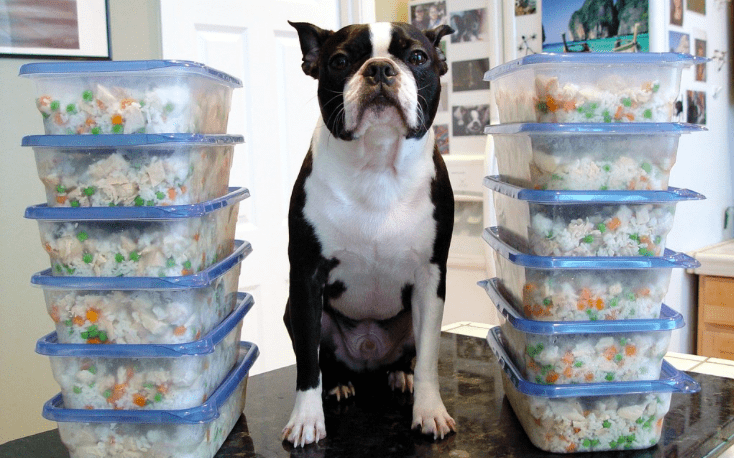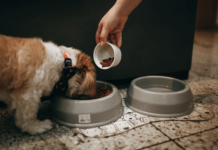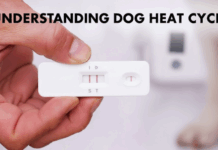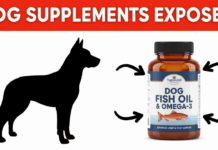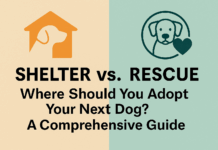Last Updated on October 31, 2023 by Dogs Vets
Can dogs eat rice?
Rice for dogs
Rice remains a staple food for more than half of the world’s population. It’s cost-effective, stores well, and is very easy to make. The good news is that dogs can also eat rice too!
In fact, rice is a great source of easily digestible carbohydrates for dogs and is well tolerated by almost all pups.
One of the most popular foods in the world is rice. But can dogs eat rice? The answer is yes. You may not realize it, but rice is an ingredient that can be found in commercial dog food.
In fact, ask many pet owners what they give their dogs when they are sick and they will tell you that white rice is part of their puppy’s diet.
One of the reasons white rice is chosen for dogs with upset stomachs is that it is easy to digest, quick to prepare, and low in fiber.
Dr. SteveWeinberg, DVM and Medical Director/CEO of 911Vets, a mobile veterinary service in the Los Angeles area, says, “Rice is a great choice for dogs with diarrhea. Rice can help bind the stool in cases of diarrhea.
Why You Should Consider Adding Rice to Your Dog’s Diet
Rice is a good substitute for grains in a dog’s diet. It provides a lot of nutrients and won’t cause any allergies.
Rice is a great substitute for grains in your dog’s diet because it provides many nutrients and doesn’t cause allergies.
Rice can be a good substitute for grains in your dog’s diet because it provides many nutrients and doesn’t cause allergies.
How Much Rice Should Dogs Eat?
Dogs are not just our pets, but they are also our friends. They deserve the same healthy diet that we give to ourselves.
Rice for dogs is a topic that has been getting a lot of attention in the last few years. It is not just about what rice to feed your dog, but how much of it too.
This article will provide you with all the information you need to know about feeding rice to your dog and why it is important for them to have a balanced diet.
Are All Rice the Same?
Brown rice is not prescribed for dogs with gastrointestinal disorders such as diarrhea. Our canine companions need starch, so it is always white rice.
However, white rice has a higher glycemic index than brown rice, which can raise blood sugar levels.
If your dog is diabetic, you can still feed a small amount of white rice if needed, but it should not be given consistently.

Due to the way brown and white rice are processed, brown rice is unprocessed and may be difficult for your dog to digest.
Brown rice has a seed coat where nutrients are stored,” explains Dr. Carly Fox, a member of the veterinary staff at the Animal Medical Center in New York City.
That coat is missing in white rice, making it less nutritious.
Carbohydrates, along with a certain amount of protein and fat, are an important part of a dog’s diet. Just like us, eating too many carbohydrates can cause your dog to gain weight.
Commercial dog foods contain carbohydrates, so be careful not to overload your dog with high carbohydrate foods such as rice.
It is perfectly fine to add rice to your dog’s diet as long as he maintains a healthy weight.
When making rice for your puppy, boil it in water and do not add any seasonings or spices. Keep it clear and simple. He will not know the difference. Also, as with any new food you introduce into your dog’s diet, consult your vet first and start slow.
Learn and know which type of rice is best for your dog and how to prepare rice so your dog can maximize the health benefits of this popular grain.
Is rice good for health?
In fact, all types of rice are a great source of minerals such as calcium and iron; it is also high in vitamins such as niacin, vitamin D, thiamin, fiber, and riboflavin.
Rice is easily digestible, has less saturated fat and good cholesterol compared to other foods. Therefore, it is good for heart health.
Take Note! : Cooked white rice and pasta. Dogs can eat cooked white rice and pasta. Boiled chicken served with white rice can also help dogs feel better when they have stomach problems.
In this section, we will be discussing the real problem with dogs eating rice.
What is The Problem With Dogs Eating Rice?
Rice is a great food for humans, but it’s not the best for dogs.
Rice is not a natural food for dogs. It’s been shown to cause stomach upset and other digestion problems. Dogs can also become addicted to rice and stop eating their normal dog food.
Why Does Rice Cause Digestive Problems in Dogs?
The food ingredients in rice are not digestible for dogs and can cause digestive problems.
The main problem with rice is the high-starch content in it. Rice contains a lot of carbohydrates that are not digestible for a dog’s stomach.
The result is that the rice will ferment in their stomach and cause digestive issues such as diarrhea, vomiting, constipation, or other signs of gastrointestinal distress.
Some dogs may also be allergic to rice which can lead to more severe reactions than just digestive problems. Some symptoms might include skin irritation, hives, or anaphylaxis.
How Can You Tell if Your Dog Has Digestive Problems?
The most common signs of digestive problems in dogs are vomiting, diarrhea, and constipation. These symptoms may come and go, or they may be persistent.
Dogs with digestive troubles can also have other symptoms such as loss of appetite, lethargy, weight loss, and a bloated abdomen.
Pros of Feeding Dogs Rice
This section will be discussing the pros of feeding dogs rice.
Rice is a good alternative for dog owners who want to feed their pets boiled rice as a substitute for dry food. Dogs can eat boiled rice but it should not be given in large quantities.
Rice is a carbohydrate and too much carbohydrates can lead to obesity in dogs. One way of making sure that your dog does not get obese is by giving them boiled rice, but only in small amounts.
Cons of Feeding Dogs Rice
Feeding dogs rice is not a good idea for many reasons. First of all, rice does not contain the necessary nutrients that your dog needs to grow and stay healthy. Rice is also very hard for dogs to digest, so it can lead to health problems like diarrhea.
Here are the Top 6 facts about feeding rice to your dog
1. Is rice good for dogs every day?
As we do, eating too many carbohydrates can cause a dog to gain weight. Since commercially produced dog food contains carbohydrates, be careful not to overwhelm your dog with extra carbohydrate-rich foods like rice. As long as your dog maintains a very healthy weight, it’s perfectly fine to add some rice to your dog’s meals.
2. Benefits of rice for dogs
Rice is high in carbohydrates but also contains protein and fiber. Bruce Fogel, DVM, MRCVS, explains in his book “Natural Dog Care, “Energy comes from the protein, fat, and carbohydrates your dog eats. Carbohydrates are converted to sugars and provide instant energy. “
Rice is also a great source of vitamin D, fiber, and iron for your dog. Vitamin D helps regulate calcium and phosphorus levels, while iron helps form hemoglobin, the molecule in red blood cells that carries oxygen.
View this post on Instagram
According to Brittany Kuenster, a licensed veterinary technician at Pet Vets in Oak Park, Illinois, rice is a good choice for dogs who have an immune response to gluten. Because rice provides important carbohydrates without gluten, it’s perfect for gluten-sensitive dogs.
These nutritional benefits are why Ollie uses rice in some of his recipes. In the Chicken Goodness recipe, rice is mixed with chicken, chicken gizzards, carrots, green peas, and more to create a balanced meal that meets the nutritional values set forth in the AAFCO Nutrient Profiles for Dog Foods for All Stages of Life.
3. Can dog’s eat white rice?
Sure. White rice – rice that has had the husk, bran, and germ removed – is a healthy part of a balanced diet for dogs.
The absence of the husk means that white rice contains less fiber and slightly more calories and carbohydrates than brown rice. It is easier on dogs’ digestive systems, making it a good choice for dogs that suffer from gastrointestinal distress or have sensitive stomachs.
Plain white rice mixed with chicken is sometimes recommended by veterinarians for dogs with diarrhea. The fiber and starch in white rice help bind the stool and soothe the intestines.
4. Can dog eat brown rice?
Brown rice is less processed than white rice and retains the hull, bran and germ. It contains slightly less protein and carbohydrates, but more fiber than white rice.
Brown rice has the same nutritional benefits for dogs as white rice and actually contains more antioxidants.
However, due to its coarser texture, some dogs have difficulty eating brown rice. White rice is also a better option for any dog that suffers from gastrointestinal distress.
5. How to cook rice for your dog
When it comes to cooking rice for your dog, plain is the name of the game. Don’t add salt or pepper, and don’t mix in onions or garlic, which can be harmful or even toxic to dogs.
Be sure to cook the rice according to the directions in the package until it is mushy to avoid digestive problems associated with uncooked rice.
Rice is high in calories and should not make up more than 10 percent of your dog’s diet.
6. Possible benefits of rice for dogs
Rice belongs to a group of foods called cereals (sometimes referred to as grains). Grains are seeds of grasses that have been grown and harvested for consumption.
They also include foods such as bulgar wheat, oats/oatmeal, corn, barley, millet, and quinoa.
As with human nutrition, animal nutrition is not about the ingredients, but about the nutrients those ingredients provide.
Not all grains are nutritionally equal. Quinoa, for example, is rich in protein. Bulgar is rich in fiber. Even corn contributes essential fatty acids and antioxidants.
Brown rice, in particular, is an excellent source of easily digestible carbohydrates as well as beneficial minerals and B vitamins.
Brown rice is nutritionally denser than white rice due to its processing. It contains more protein, more fiber, and less starch than white rice. Also, because brown rice is not as processed as white rice, it contains more vitamins and minerals than white rice.
View this post on Instagram
The high fiber content of brown rice can help with constipation. White rice, on the other hand, is easier to chew and digest, cooks faster, is less expensive, and is better for dogs with upset stomachs or diarrhea than brown rice.
However, white rice has a higher glycemic index than brown rice, so white rice can cause your dog’s blood sugar levels to rise and fall more than brown rice.
Calories from rice should not exceed 10 percent of your dog’s daily caloric intake. Feeding your dog small, frequent portions of rice can help keep your dog from gaining weight.
When preparing rice, it should be cooked in plain water and free of spices or seasonings.
FAQ’s
What kind of rice can dogs eat?
Both white and brown rice are good for dogs. Brown rice,” Dempsey explains, “is browner than white rice because it still has the outer layer of grain or outer layer and bran. This means it has more fiber than white rice and also retains natural oils. Brown rice is prone to spoilage when stored.
Can Rice Upset a Dog’s Stomach?
Chicken and rice are the main ingredients in many dog foods, and these mild foods go well with a dog’s upset stomach. Oil, butter, and additional seasonings can irritate a dog’s stomach and exacerbate the problem, so stick to plain-boiled chicken and rice and save the extras for your own meals.
Can I feed my dog rice and chicken daily?
It is not a good idea to keep your dog on a daily diet of chicken and rice for long. While this dish is very healthy for dogs, it does not contain all the necessary nutrients that can be obtained from other sources such as red meat and vegetables!
What are the foods that can kill a dog?
Top 7 Human Foods That Can Be Deadly to Dogs
- Avocados. Avocados contain a toxin called persin.
- Xylitol. Xylitol is a sugar alcohol often used to sweeten candy, chewing gum, toothpaste, and baked goods.
- Caffeine in coffee, tea, and other beverages.
- Grapes and raisins.
- Alcohol and yeast dough.
- Chocolate.
- Salt.
What are the best human foods for dogs?
Here are some human foods that are safe for dogs. There are also human foods that are safe for dogs to eat.
- Apples. Apples provide many important vitamins to dogs, including vitamins A and C.
- White rice
- Dairy products
- Fish
- Chicken
- Peanut butter
- Plain popcorn
- Watermelon
- String beans
- Cucumbers
- bananas
- Blueberries
- turkey
- Pork
- Carrot
Tips:
CBD can be given to dogs in various forms, such as oils, capsules, treats, or topical creams. The dosage and frequency of CBD depends on your dog’s weight, age, health condition, and individual response.
You should always consult your veterinarian before giving your dog CBD, especially if they have any pre-existing medical issues or are taking any medications.
See also: See pictures of All Dog Breeds pictures and their names from A to Z
Fact Check
We strive to provide the latest valuable information for pet lovers with accuracy and fairness. If you would like to add to this post or advertise with us, don’t hesitate to reach us. If you see something that doesn’t look right, contact us!
Reference: www.akc.org and blog.myollie.com
